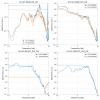Anamaria's observation that LLO DARM RMS is affected by the SRCLFF made me look again at the same well known fact at LHO. In the past we reduced a large 1.34 Hz line in DARM by improving the SRLCFF highpass (LHO:71565). So I was curious to see what's the current situation. Spoiler: not great.
The first plot compares the control signals sent to DARM: DARM_OUT, SRCLFF1_OUT and MICHFF_OUT. One can see that DARM_OUT lines up with SRCLFF between 3 and 8 Hz, and is of similar amplitude as with MICHFF between 1 and 2 Hz. So it looks like most of the actuation to DARM is actually due to the SRCLFF, and the DARM loop is probably counteracting that force (indeed the transfer function between DARM_OUT and SRCLFF1_OUT is -1 between 1 and 8 Hz) . SRCLFF seems to be doing a good job of subtracting SRCL from DARM above 8 Hz, but doing nothing good below 8 Hz.
The second plot compares the DARM input and output signals during a brief time when the MICH and SRCL FF were off (yesterday during my measurements, so SRCLFF was actually off, while MICHFF was used for some noise injection above 10 Hz). DARM residual motion is lower between 1.5 and 8 Hz when the FF are off. The total RMS of DARM residual motion is increased by a factor 2.2 by the LSC FF (mostly SRCL)
How can we fix this?
- look at what is the origin of SRCL motion between 1 and 8 Hz, and reduce it. My bet is on SRx top stage damping
- measure the actual SRCL to DARM coupling (and the DARM loop response) between 1 and 8 Hz, and try to fit the SRCL FF to match the real coupling
Another question is of course: should we fix this? Or in other words, is it a problem? LLO saw evidence of noise modulation because of this effect (LLO:66597)
SRCL is highly coherent with SRM DAMP_L at the 1.3 Hz peak and below: SUS-SRM_M1_DAMP_L_IN1_DQ
And highly coherent with SR2 DAMP_P between 3 and 8 Hz: SUS-SR2_M1_DAMP_P_IN1_DQ



